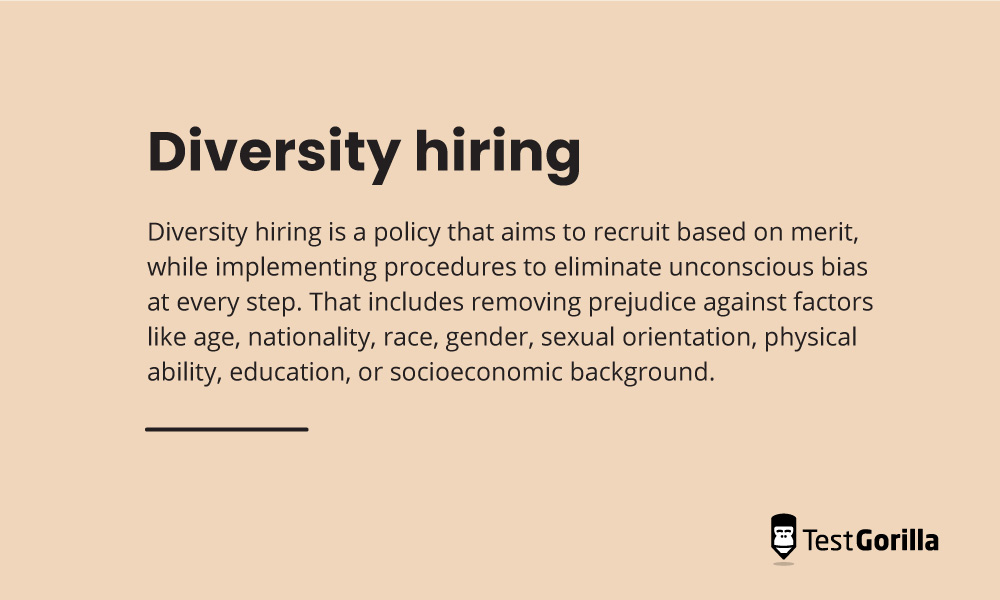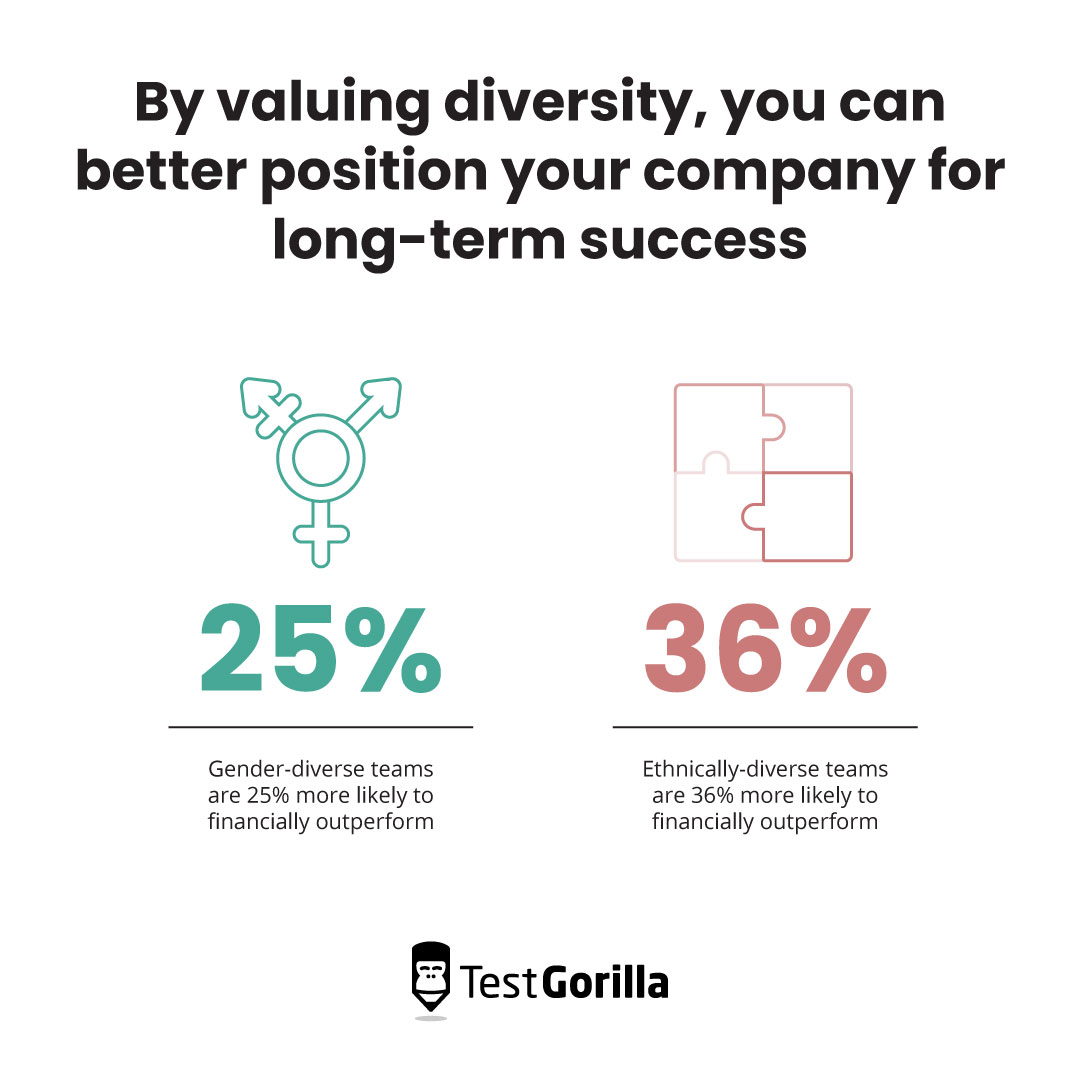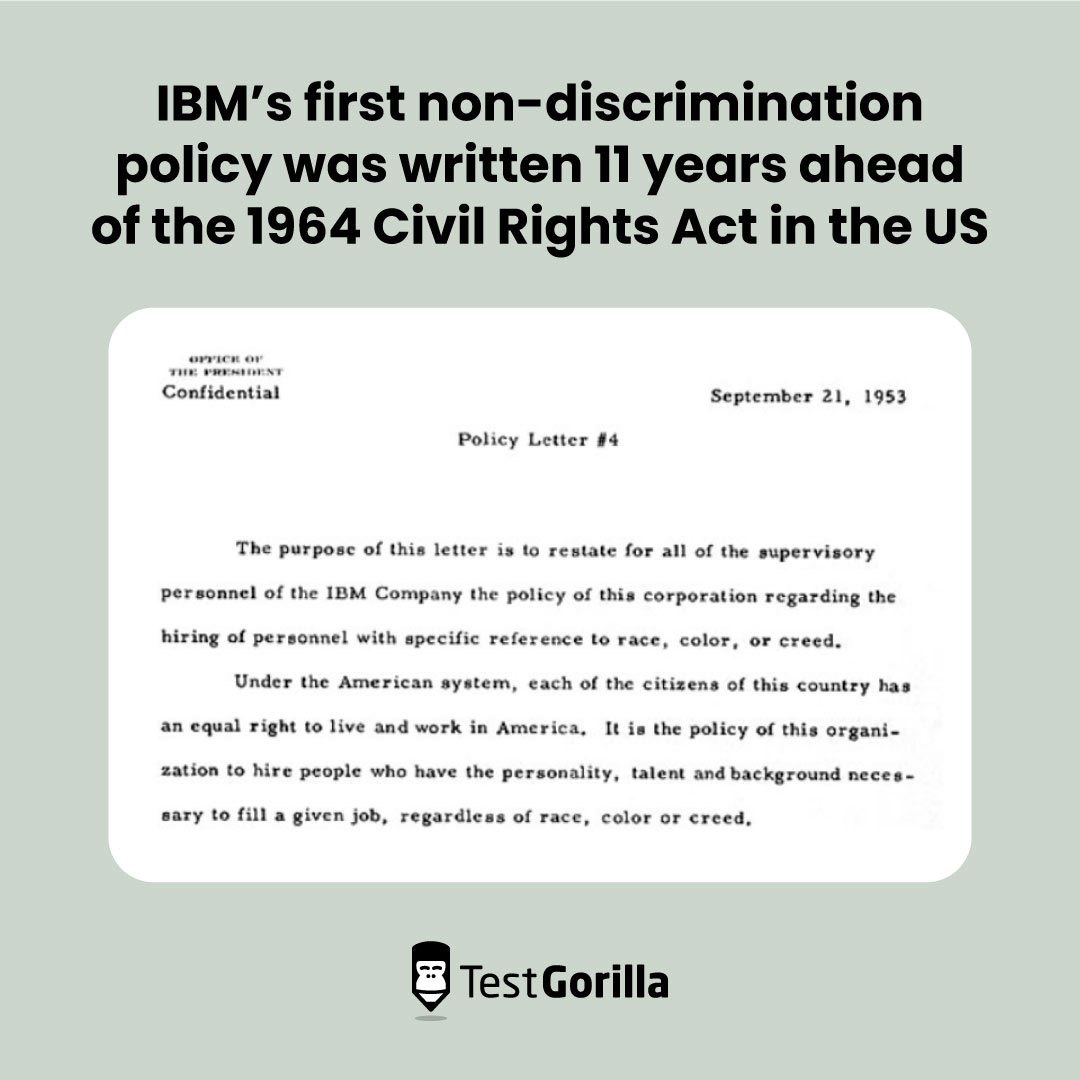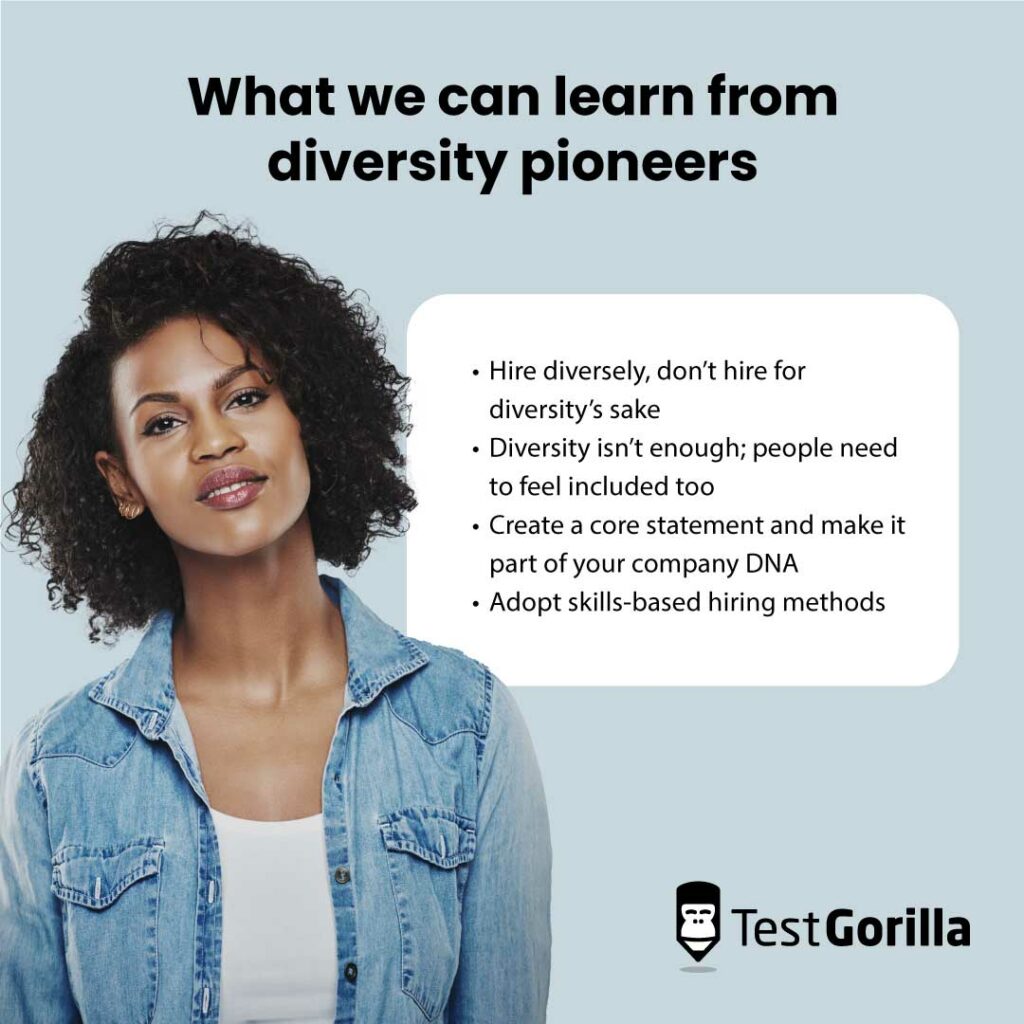On the right side of history: What diversity pioneers can teach us
Time and time again, studies have proven that diverse companies perform better.[1] Whether it’s about meeting a moral obligation, or creating teams that financially outperform and solve problems more creatively, hiring diversely benefits people, organizations, and the communities they serve.
Some of the most important steps toward diversity and inclusion in the workplace involve adopting unbiased hiring practices, like using blind resumes and pre-employment testing, creating inclusive company policies, and proactively making your people feel included.
In this piece, we look at four companies that pioneered diversity and inclusion policies and what they achieved as a result. We also look at what these organizations can teach us about objective and unbiased hiring and promoting practices – so we can all be part of the change.
Table of contents
What is diversity hiring and why does it matter?
Diversity hiring isn’t about hiring for diversity’s sake or meeting a certain quota. It’s a policy that aims to recruit based on merit, while implementing procedures to eliminate unconscious bias at every step. That includes removing prejudice against factors like age, nationality, race, gender, sexual orientation, physical ability, education, or socioeconomic background.
The goal of diversity hiring is to create workplaces that are inclusive and equitable, as well as high performing. And in recent years, societal expectations are pushing companies to increasingly invest in diversity and inclusion (D&I) initiatives. Because everyone should have equal access to job opportunities, and workplaces should reflect the diversity of the communities they serve.
In addition to being the right thing to do, there’s also a business case for diversity hiring. Organizations with a diverse workforce are more creative, innovative, and effective than those with teams from a narrow range of backgrounds. They also better reflect and serve the needs of a diverse client base, which helps them access new markets.
This policy can also help companies attract and retain top talent. Employees are increasingly looking for workplaces that prioritize D&I, and companies that can offer this are more likely to be seen as desirable employers. In fact, 40% of employees say they would switch jobs just to be part of a more inclusive work culture.[2]
By valuing diversity, you create a more engaged and motivated workforce and can better position your company for long-term success in a rapidly changing global marketplace.
Data shows that diverse teams are more innovative and effective than homogeneous teams, with ethnically-diverse organizations being 36% more likely to financially outperform.Source: 2022 State of Skills-based Hiring Report
4 diversity pioneers and what they achieved
Let’s take a look at four diversity pioneers and how they’ve committed to D&I policies over the years, to give you some inspiration in developing your own diversity hiring practices.
1. IBM
IBM’s commitment to diversity spans over 100 years, predating current conversations. As early as its founding in 1911, the company employed people from various backgrounds and marginalized communities. It hired its first employee with a disability in 1914, and wrote its first non-discrimination policy in 1953. This statement called for objective, unbiased hiring and aimed to provide equal opportunity to all “IBMers.”
IBM’s first non-discrimination policy was written 11 years ahead of the 1964 Civil Rights Act in the US.Source: IBM
What makes this company a diversity pioneer is its commitment to continuous change and making D&I part of its organizational DNA. IBM believes that having a diverse and inclusive workforce is essential to its success, as it helps foster innovation and creativity as well as being a moral obligation. That’s why the company has implemented several policies and initiatives to make sure it’s an inclusive and welcoming workplace for all employees.
In the 1990s, when Louis Gerstner became CEO, he worked with Ted Childs, the vice president of global workforce diversity, to devote more attention to diversity. One of the ways they did this was by establishing eight task forces, each devoted to understanding the challenges and needs of a specific group of employees. More specifically, Black, Asian, Native American, LGBTQ+, and Latinx workers. Along with men, women, and people with disabilities.
In addition to leading the diversity charge, Childs created networks for marginalized groups and mentoring programs, promoting communication outreach and education.
In 2008, IBM began promoting cultural intelligence as part of its D&I initiatives. This program centered around the belief that a greater understanding of each other’s differences is the key to effective collaboration. Several cultural communities were created across the organization to support marginalized employees.
The company also proactively advocates for diversity by supporting various bills brought to the US Congress. For example:
Publicly supporting the passage of legislation in Arkansas to prevent hate crimes in January 2021.
Supporting the Equality Act in February 2021.
Launching a technology platform, as a part of the OneTen coalition, to create and enable one million career opportunities for Black individuals over the next 10 years in June 2021.
All of IBM’s conscious decisions in favor of D&I make it a leader in diversity and a great place to work. According to Forbes, it is the third-best employer in a list of 800 global companies.[3]
Interested in learning more about IBM’s diversity timeline and unique initiatives? Check out its history here.
2. Accenture
Accenture, a global software and IT services company, is well known for its strong commitment to D&I. In 2016, it became the first professional services company to publish demographic data about its US workforce. And it’s done so every year since.
The company believes that this level of transparency keeps it accountable and gives it the information it needs to further its D&I initiatives. In fact, Accenture was voted the number one company on Refinitiv’s Diversity & Inclusion Index for its dedication to creating a diverse and welcoming place to work in 2022.[4]
One of the key policies that Accenture has implemented is its Global Code of Business Ethics, which outlines the company’s commitment to D&I.[5] The code sets out the standards of conduct that all Accenture employees, business entities, and third parties acting on its behalf are expected to follow. It includes provisions relating to discrimination and harassment, as well as a commitment to fostering respect, fairness, and shared ethical values.
Accenture has also introduced several policies and initiatives to ensure that it’s a welcoming workplace for its people. For example:
Flexible work arrangements. Employees have control over their schedules and working hours. Accenture also offers part-time arrangements and allows people to work remotely. This gives individuals of all backgrounds and lifestyles the opportunity to thrive at the company.
Talent development. Accenture offers specialized training, mentorship opportunities, and personal development programs for all its employees. In 2022, it invested $1.1 billion in learning and development initiatives, which has helped the company remain competitive, while giving everyone equal opportunities for growth.
Gender equality and inclusion. The company continues to make progress toward a gender-balanced workplace. Currently, 47% of the workforce are women, as are 50% of new hires. The goal is to achieve a 50% female-to-male ratio throughout the organization, and grow the percentage of female managing directors to 30% by 2025. (It’s currently 29%.)
LGBTQ+ inclusion. According to Accenture, it has 120,000 Pride allies across all the countries it operates, and employee resource groups in 45 countries.[6] It also offers transgender health benefits in 17 countries and equal benefits to same-sex couples. These benefits, along with the networks and resource groups, create a psychologically safe environment and allow people to be their true selves at work.
Accenture operates in 120 countries. Curious to know how equality policies look worldwide? Check out our guide to Global equality policies: are some more equal than others?
3. Bank of America
Bank of America, one of the world’s largest financial institutions, recognizes that having a diverse workforce is essential to its success, as it helps foster innovation and drive business growth. It also works to diversify its workforce to better meet the different needs of its equally diverse client base. The company strives to expand its talent pool, work with diverse suppliers, and create a diverse and inclusive environment for its associates and their families.
Bank of America has implemented a range of initiatives to promote D&I, starting at the top of the organization. “Our Board, its committees, and our CEO play a key role in the oversight of our culture,” the bank notes, “holding management accountable for ethical and professional conduct and a commitment to being a great place to work.”
One of the key policies the bank has implemented is its Global Diversity & Inclusion Council, which is the governing body responsible for overseeing the company’s D&I initiatives. The council is made up of senior leaders from across the company, and is responsible for setting goals and tracking progress.
The organization’s management team sets the D&I goals of the company. Each team member has action-oriented diversity goals, which are reviewed quarterly by the board and used as part of talent planning. They also cascade goals, which means first establishing them at the highest level of the organization and then creating supporting goals for every team and individual to ensure commitment and accountability throughout the company.
Additionally, the bank runs yearly internship outreach programs that aim to recognize top campus talent from historically underrepresented backgrounds in the financial industry – specifically Black, Latinx, Native American, LGBTQ+, military veterans, women, and people with disabilities. Attendees can then receive business-specific seminars, join D&I discussions, interview for internships or full-time roles, and build their network.
Bank of America has also established a range of partnerships and initiatives to support D&I more broadly. For example, the company partners with the National Urban League to provide training and job opportunities for underserved communities, and has established a range of programs to support military veterans and their families.
Finally, Bank of America is one of the biggest companies using skills-based hiring and interviewing. Hiring managers interview candidates for competencies and use skills-based exercises, assessments, and screening to measure key aptitudes, attributes, and values they’re looking for.
They also question applicants on their experiences working with people of different backgrounds and varying ideas, to gauge their abilities in working with diverse teams. This helps ensure a continued dedication to D&I at the bank.
Want to dig a little deeper into skills-based hiring practices and how it benefits your people and organization? Check out our guide to The rise of skills-based hiring: Past history and current trends.
4. Browne Jacobson
Browne Jacobson is a leading UK law firm that has introduced several D&I policies to develop a culture of inclusivity and respect, and help everyone that works there feel valued. Like the Bank of America, it wants its workforce to be reflective of the clients it serves, and even has the aspiration of being “the most inclusive and diverse law firm in the UK.”
It recognizes that lasting change in the legal sector requires greater accessibility to senior positions. So it has set targets to increase the representation of female and UK ethnic minorities to at least 45% and 10% respectively by 2026.
The firm is also taking action by:
Ensuring equitable promotion processes. The firm conducts succession planning for key leadership roles and has developed mentoring and support programs in different parts of the organization to “remove perceived barriers to female progression.”
Rolling out mandatory anti-racism training across the firm, starting with leadership. It also developed a mentoring scheme to increase Black representation, and publishes data (like its 2021 ethnicity pay gap report) to stay accountable for its policies and actions.[7]
Championing people with disabilities. Browne Jacobson trains key teams in British Sign Language. It also partners with the Business Disability Forum with the aim of getting “Disability Smart” accreditation.
Promoting social mobility. In 2016, the firm removed its requirement for minimum A-level grades for trainees, and has now started anonymizing all application forms and resumes.[8] This is done to level the playing field, eliminate unconscious bias, and allow the firm to evaluate candidates based on their competencies.
Browne Jacobson provides a six-month, 1:1 mentoring program with lawyer members of its REACH (Race, Ethnicity, and Cultural Heritage) community. It also offers two weeks of paid work experience at one of the firm’s five offices.[9]
By providing students with real-life work experience and mentorship, this firm expands their network and helps them build stronger resumes. At Browne Jacobson, mentors come from different legal sectors, career levels, and backgrounds. In this way, every student can benefit from the program, no matter what their background or personal circumstances may be.
Finally, the firm uses the RARE contextual recruitment system to recruit graduate trainees. This allows it to contextualize applications and measure against academic performance for a fairer process.
What we can learn from diversity pioneers
In the last two decades, there’s been growing recognition of the importance of D&I in workplaces around the world. And while many organizations are still grappling with how to promote D&I effectively and make their companies great places to work, some pioneers have really blazed a trail. They’ve demonstrated what’s possible when the program is taken seriously.
Here are some ways you can learn from the four organizations above and develop a D&I strategy for your company, regardless of your industry:
Hire diversely, don’t hire for diversity’s sake. For your D&I policies to be most effective, your hiring strategies should go beyond tokenism and hiring for the sake of diversity. Instead, implement procedures to eliminate unconscious bias and hire based on merit. Take Browne Jacobson as an example.
Diversity isn’t enough; people need to feel included too. Simply increasing representation from underrepresented groups in your workplace doesn’t make your company a better place. Your employees need to feel included, psychologically safe, and equal. Learn from Accenture and offer benefits like flexible work, trans health benefits, and assistive technology for people with disabilities.
Create a core statement and make it part of your company DNA. Outline what D&I means to your company and the steps you’ll take to implement it. Having a clear statement drives alignment across the organization and provides a benchmark for hiring, retaining, and developing individuals. Working the statement into every aspect of your company, like IBM, sets you apart from competitors and helps make your organization a welcoming space for all.
Adopt skills-based hiring methods. Competency-based hiring practices give everyone a fair chance regardless of their sex, gender, background, physical ability, and education. According to our 2022 State of Skills-based Hiring Report, 91% of employers who used skills-based hiring saw an increase in diversity, and 92.7% reduced the number of mis-hires. 72.1% of the people hired are happier too, leading to increased retention rates. Take a look at how Bank of America uses competency-based recruitment to find the best talent.
We’ve seen the impact of using skills-based hiring in the US and UK, but how does it look around the world? Take a look at our guide to Skills-based hiring around the world to learn more.
Learning from diversity pioneers: How to take D&I to the next level
Diverse teams perform better. They’re more creative, innovative, and likely to financially outperform homogenous teams. They’re also happier and better able to meet the needs of an equally diverse client base. But if you want to improve diversity, you need to adopt a more equitable approach to hiring and recruiting in ways that are less prone to bias.
That’s why in this article, we looked at the hiring and retaining practices of four diversity pioneers around the world. Some with long histories of D&I, like IBM, and others with shorter, but just as promising records. These four organizations commit to D&I by:
Developing comprehensive policies
Remaining flexible and adapting to the world’s diverse needs
Publishing workforce data to increase transparency and accountability
Offering flexible work arrangements to empower a wide variety of people and backgrounds
Creating a psychologically safe work environment
Utilizing skills-based recruitment methods
Partnering with nonprofits and other community organizations to access talent in underserved communities
Ensuring equitable promotion processes
These companies are tackling a lack of inclusion by implementing initiatives aimed at attracting, retaining, and promoting individuals from various backgrounds. By studying their successes and learning from their experiences, you can gain valuable insights into how to promote D&I in your own organization and help create a more inclusive and equitable world.
Want a more effective way to hire talent? Find out how skills-based hiring can help you build diverse and inclusive teams from a wide talent pool Download the 2022 State of Skills-based Hiring report to learn more.
Sources
“9 Companies Around the World That Are Embracing Diversity in a BIG Way.” SocialTalent. Accessed February 21, 2023. https://www.socialtalent.com/blog/recruiting/9-companies-around-the-world-that-are-embracing-diversity
“Diversity, Equity, and Inclusion as a key retention strategy.” QuestionPro. Accessed February 21, 2023. https://www.questionpro.com/diversity-equity-inclusion-study.html
“World’s Best Employers.” Forbes. Accessed February 21, 2023. https://www.forbes.com/lists/worlds-best-employers/?sh=1d5ef4281e0c
“Our Diversity and Inclusion Index.” Refinitiv. Accessed February 21, 2023. https://www.refinitiv.com/en/financial-data/indices/diversity-and-inclusion-index
“Code of Business Ethics.” Accenture. Accessed February 21, 2023. https://www.accenture.com/content/dam/accenture/final/a-com-migration/pdf/pdf-63/accenture-cobe-brochure-english.pdf
“Pride at Accenture.” Accenture. Accessed February 21, 2023. https://www.accenture.com/ch-en/about/inclusion-diversity/lesbian-gay-bisexual-transgender
“Pay Gap Report April 2021.” Browne Jacobson. Accessed February 21, 2023. https://www.brownejacobson.com/about/legal-notices/pay-gap-reports/2021
“Diversity and Inclusion.” Browne Jacobson. Accessed February 22, 2023. https://www.brownejacobson.com/about/diversity-and-inclusion
“Browne Jacobson launches dedicated Black lawyers mentoring scheme to further improve diversity.” Browne Jacobson. Accessed February 21, 2023. https://www.brownejacobson.com/about/news-media/launches-dedicated-black-lawyers-mentoring-scheme
Related posts
You've scrolled this far
Why not try TestGorilla for free, and see what happens when you put skills first.
Latest posts
The best advice on pre-employment testing, in your inbox.
No spam. Unsubscribe at any time.

Hire the best. No bias. No stress.
Our screening tests identify the best candidates and make your hiring decisions faster, easier, and bias-free.
Free resources
This checklist covers key features you should look for when choosing a skills testing platform
This resource will help you develop an onboarding checklist for new hires.
How to assess your candidates' attention to detail.
Learn how to get human resources certified through HRCI or SHRM.
Learn how you can improve the level of talent at your company.
Learn how CapitalT reduced hiring bias with online skills assessments.
Learn how to make the resume process more efficient and more effective.
Improve your hiring strategy with these 7 critical recruitment metrics.
Learn how Sukhi decreased time spent reviewing resumes by 83%!
Hire more efficiently with these hacks that 99% of recruiters aren't using.
Make a business case for diversity and inclusion initiatives with this data.





















